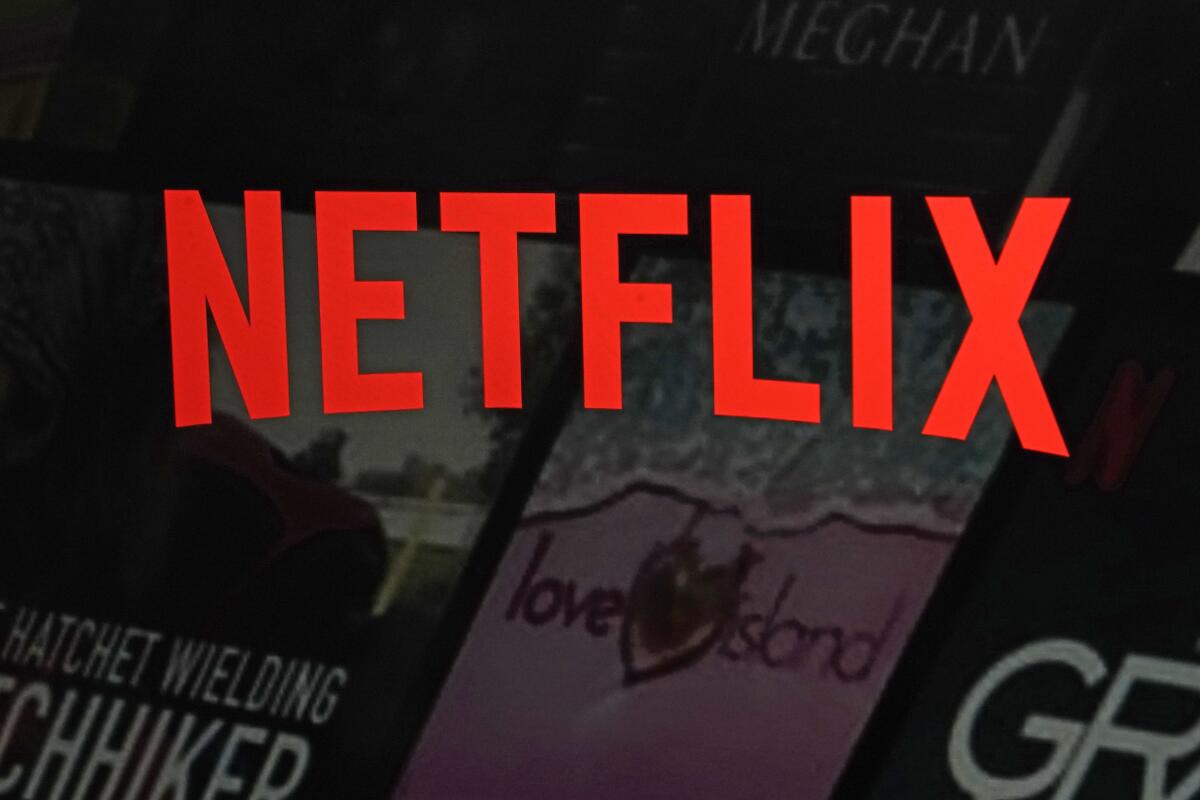Will Netflix get into the TV news business? Here are the pros and cons

- Share via
When Netflix announced last month that it had acquired the rights to two NFL football games to stream on Christmas Day, TV news agents were buzzing.
If the streaming behemoth is getting into sports — after saying for so long that it wouldn’t — could live news shows be far behind as the Los Gatos, Calif., streaming giant diversifies its programming roster?
Think of the ease of a button on the Netflix home screen that could take users to a breaking story, such as last week’s guilty verdict in former President Trump’s hush money trial in New York. Or consider how Netflix, which has 270 million users worldwide, could send out an alert to get viewers to watch coverage of the State of the Union address or a presidential debate.
Nielsen data for April show that Netflix is the second most-watched source for television viewing, accounting for 7.6% of all TV consumption behind YouTube’s 9.6%. Live news would give users another reason to log in at a time when they are looking to consolidate the number of streaming services they pay for each month.
Also, it would expand on what Netflix is doing with live broadcasts in other genres, such as the company’s star-studded “The Roast of Tom Brady” and the Netflix Slam tennis tournament.
Last year, Netflix added a subscriber tier where users who sit through sponsor messages pay a lower monthly fee. Live content such as the NFL and the WWE’s weekly “Raw” show (coming to Netflix next year) will have commercials, bringing Netflix ad revenue in addition to subscriber fees. The company demonstrated its commitment to capturing a share of the TV ad market with its first glitzy, in-person upfront sales presentation in New York last month.
Live news is an effective way to get audiences to sit through ads. After diving into sports, news could be a logical next step for the company as it seeks to become viewers’ one-stop shop for TV viewing.
It would certainly be a welcome development for people who represent on-air news talent. The traditional TV networks that pay their clients handsomely are losing audience and revenue. Some agents fear significant downsizing and cost-cutting after the 2024 presidential election in November and nothing would lift their spirits more than having a new, deep-pocketed bidder enter the playing field.
The company has internally discussed the opportunities in news, just as it has for many formats on traditional TV that attract audiences. But when asked about any plans along those lines, a Netflix representative cited a recent interview with Netflix Chief Executive Ted Sarandos in which he said the platform has no plans to pursue breaking news.
But what the TV industry has learned about Netflix is that it can quickly change its mind.
“Netflix also said they were never going to do sports, right?” said Bill Hague, executive vice president for Magid, a media consulting company. “And they said they were never going to do advertising and they’ve done that. These are not firm lines in the sand.”
Still, veterans of the TV news business have some advice for Netflix: don’t do it.
“I think it would be ill-advised for Netflix to get into live news,” said Andrew Heyward, a former president of CBS News who now is a strategic advisor to local TV stations. “There are excellent players doing it now who are struggling.”
In a week that was once all about ABC, CBS, NBC and Fox, Amazon and Netflix make their presence felt as they seek a piece of the $27-billion upfront ad market.
One reason is that news is not quite like sports. League media rights fees have escalated in recent years, because live game telecasts are the most reliable way to attract large audiences for appointment viewing. The buyers of those rights have some degree of certainty of what they are getting when they sign the deal. Not so with news.
“In sports you know where the cameras are beforehand and everything is exclusive,” Heyward said. “The big difference between sports and news is having to pay to be prepared for the unexpected. It’s a very unattractive financial proposition.”
News is not only unpredictable but expensive to produce and perishable after it goes on the air. Breaking coverage is not exclusive to a single outlet. Live feeds of events are now ubiquitous in the streaming and social media era.
Internet-connected televisions give consumers the news through free, ad-supported streaming channels, such as CBS News 24/7 or NBC News Now, without charging for a subscription.
As Heyward noted, there isn’t enough demand for the news content already available.
Cable news remains highly profitable, but cord-cutting is slowly depriving them of the subscriber fees that have sustained the businesses for decades. Younger consumers are bypassing traditional TV and not developing the habit of news viewing (although many network news programs are repeated on their favorite platform, YouTube).
News sources across the media — from newspapers to podcasts — are suffering significant audience declines and downsizing after the heady years of the Trump White House.
Some legacy media executives probably have daydreams about exiting the news business as the path to profitability becomes more challenging. Last year, Walt Disney Co. Chief Executive Bob Iger publicly said the company’s linear TV networks, which includes ABC News, were not core to the company’s business and he could envision spinning them off.
He later backtracked and said ABC was not for sale.
The stir caused by Iger’s remarks demonstrates how news is ingrained in the culture of the broadcast business. In the early decades of the TV, it was acceptable for news to be a financial loss leader. The news divisions were considered a public service necessary to maintain the networks’ right to use the nation’s airwaves for free.
They also built stature for their parent companies. Affiliate stations still depend on the national broadcast networks for news to supplement their own local coverage. News provides a brand identity for networks, right down to the logo painted on production trucks that show up for live shoots on a neighborhood corner.
Networks became more cost conscious about news when the business matured and shareholders demanded better financial performance.
Veteran news executives doubt Netflix would want to take on the pressures of entering a crowded, competitive field that invites scrutiny, requires transparency and often creates controversy. “It’s a big expense and it’s a headache,” said one former broadcast network chief.
Netflix would be better off licensing programs produced by an existing news organization that already has a news-gathering infrastructure in place, several TV executives said. (Netflix carried original shows from CNN before Warner Bros. Discovery moved them over to its streaming service Max, which now offers a streaming feed of the channel.)
While news is not on Netflix’s agenda now, Magid’s Hague expects the company to respond if the need arises.
“If you’re going to try to reduce subscriber churn and increase lifetime value of your service, you have to really provide a very complete meal to your consumers,” said Hague. “I think they’re playing with what’s the right mix — and that mix will always change.”
More to Read
Inside the business of entertainment
The Wide Shot brings you news, analysis and insights on everything from streaming wars to production — and what it all means for the future.
You may occasionally receive promotional content from the Los Angeles Times.












